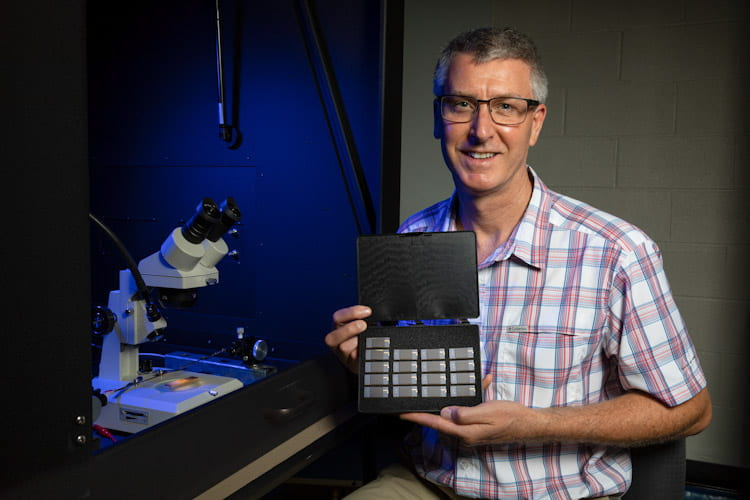Oct 5 2020
Physicists from the University of Arkansas have successfully built a circuit that can capture graphene’s thermal motion and turn it into electrical current.
 Paul Thibado holds prototype energy-harvesting chips. Image Credit: Russell Cothren.
Paul Thibado holds prototype energy-harvesting chips. Image Credit: Russell Cothren.
An energy-harvesting circuit based on graphene could be incorporated into a chip to provide clean, limitless, low-voltage power for small devices or sensors.
Paul Thibado, Study Lead Researcher and Professor of Physics, University of Arkansas
The study results, reported in the Physical Review E-journal, are proof of a theory formulated by the physicists at the University of Arkansas three years ago that freeform graphene—a single layer of carbon atoms—ripples and buckles in a manner that could exhibit the potential for energy harvesting.
The concept of harvesting energy from graphene is debatable since it refutes physicist Richard Feynman’s famous declaration that the thermal motion of atoms, called Brownian motion, cannot perform work. Thibado’s team discovered that at ambient temperature, graphene’s thermal motion does actually stimulate an alternating current (AC) in a circuit, a feat believed to be impossible.
Physicist Léon Brillouin, in the 1950s, published a revolutionary paper countering the idea that incorporating a single diode, a one-way electrical gate, to a circuit is the key to harvesting energy from Brownian motion. Being aware of this, Thibado’s team designed their circuit with two diodes to turn AC into a direct current (DC).
With the diodes in opposition permitting the current to travel both ways, they offer independent paths via the circuit, thereby generating a pulsing DC current that carries out work on a load resistor.
Moreover, they learned that their design boosted the amount of power supplied.
We also found that the on-off, switch-like behavior of the diodes actually amplifies the power delivered, rather than reducing it, as previously thought. The rate of change in resistance provided by the diodes adds an extra factor to the power.
Paul Thibado, Study Lead Researcher and Professor of Physics, University of Arkansas
The researchers used a comparatively new area of physics to establish that the diodes boosted the power of the circuit.
“In proving this power enhancement, we drew from the emergent field of stochastic thermodynamics and extended the nearly century-old, celebrated theory of Nyquist,” said coauthor Pradeep Kumar, associate professor of physics and co-author.
Kumar stated that the circuit and graphene share a symbiotic connection. Although the thermal environment does work on the load resistor, the circuit and graphene are at the same temperature and heat fails to travel between the two.
According to Thibado, that is a crucial difference because a temperature variance between the graphene and circuit, in a circuit that generates power, would oppose the second law of thermodynamics.
This means that the second law of thermodynamics is not violated, nor is there any need to argue that ‘Maxwell’s Demon’ is separating hot and cold electrons.
Paul Thibado, Study Lead Researcher and Professor of Physics, University of Arkansas
Moreover, the researchers found that the comparatively slow motion of graphene stimulates current in the circuit at low frequencies, which is significant from a technological standpoint because electronics run much better at lower frequencies.
“People may think that current flowing in a resistor causes it to heat up, but the Brownian current does not. In fact, if no current was flowing, the resistor would cool down,” Thibado clarified. “What we did was reroute the current in the circuit and transform it into something useful.”
The next step for the team is to establish whether the DC current can be captured in a capacitor for use at a later time—a goal that necessitates miniaturization of the circuit and patterning it on a silicon wafer, or chip. If millions of these miniature circuits could be constructed on a 1 mm x 1 mm chip, they could act as a low-power battery substitute.
The University of Arkansas has several patents pending in the U.S. and global markets on the technology and has licensed it for commercial applications via its Technology Ventures unit.
Other contributors to this research are scientists Surendra Singh, University Professor of physics; Hugh Churchill, associate professor of physics; and Jeff Dix, assistant professor of engineering. This study was financially supported by the Chancellor’s Commercialization Fund sponsored by the Walton Family Charitable Support Foundation.
Graphene Animation
Thibado’s energy-harvesting circuit uses the atomic motion of graphene to generate an electrical current that can perform work. Video Credit: Ashley Acord.
Journal Reference:
Thibado, P.M., et al. (2020) Fluctuation-induced current from freestanding graphene. Physical Review E. doi.org/10.1103/PhysRevE.102.042101.